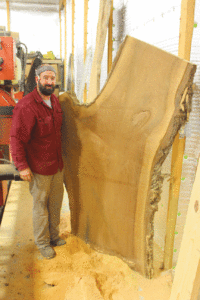
Knots, branches and other aspects a typical lumber sawmill wouldn’t want in a tree bring character to the pieces at David Boyle’s Wood Ingenuity.
Ever since the sawmill capable of cutting logs larger than five feet in diameter arrived in 2014 starting his business Wood Ingenuity, David Boyle has had his big tree radar cranked up.
“I was bad about it,” he admits of those early years searching for large trees. “If I’m riding with someone, I’m always looking for trees.”
Along with scanning every stand of trees he passed, he also made a habit of stopping by tree crews working along power lines and highways, asking if they could set aside the big ones for him.
David and his father, Jim Boyle, started the business in Queen Anne, after a storm brought down a large White Oak at Jim’s farm. Jim wanted to get the tree cut into lumber to use on the farm but was unable to find a sawmill large enough to cut the huge log, even after it was sliced in half.
A year later, they had a saw with 67-inch diameter capacity and were up and running, cutting the trees into thick slabs for furniture and other craftsman projects.
Spence Logging and Hauling in Easton has been key in helping to retrieve many of the large trees and they also get a lot of help from local tree services who often make customers aware of Wood Ingenuity, David said.
“We’re pretty wealthy in our area for old large trees,” David said, noting many estates up and down the shore have played a big partin keeping trees maintained for so long. “We just saw an opening in the market and a need.”
More than five years later, the Boyles have amassed an extensive inventory of cut wood from large oaks, maples, walnuts and other trees that were taken down by storm or chain saw and would otherwise get pushed deeper into the woods, mulched or taken to the landfill.
Saved from the trash, the logs now get the chance to become unique pieces of furniture or building components.
Even the sawdust and other leftovers from their milling is reused as heat through the shop’s wood stove.
“We’re really taking what nobody else wants,” David said. But that changes once it goes through their saw. Part of their allure is in keeping the tree’s live edge. He may scrape the bark off, but all the curves and nuance of the tree’s exterior remain, an aesthetic that’s become used more often in interior design.
“We’re so disconnected from nature, it’s like having a tree in your house,” he said.
David said the more things that would get a log downgraded at a typical lumber mill, the more he’s interested in sawing it.
Knots and crotches — even some cases of pest damage — add character to the slabs that someone may one day rest a dinner place setting, a pint of craft beer, or treasured family heirlooms.
“Doing what we’re doing with the live edge, we’re cutting furniture, we’re not cutting boards.”
While tables and bar tops in homes and restaurants are a common use of the wood, David has sawed mantels, beams, cabinets, flooring and other creative projects from the logs. Since Wood Ingenuity began, some of the trees David has worked on have historical value to match their size.
His inventory includes an ash tree from the Governor’s Mansion in Annapolis, wood from the 400-plus year old swamp chestnut oak that once stood at St. Paul’s Parish in Chestertown and a 350-year old red oak tree locally named the Pacman Tree that came down in the 2017 tornado destruction on Kent Island.
Many other trees carry tremendous meaning to the owner of the property they came from, and turning its wood into an item that can decorate the home or be passed down to children and grandchildren is a way people are preserving that history, David said.
Others are happy just knowing the tree didn’t go to waste.
With the old age of many of the large trees, David said the sawing often unlocks some history of the area the tree came from. He said he has sawed through bullets, Civil War-era shotgun slugs, glass, nails and other items that have gotten surrounded by the tree over time.
Along with being a source of the large slabs for other craftsman, David has years of carpentry and contracting experience of his own, and can carry projects from log to finished furniture all in his own shop, which he said is the most intriguing part of his work.
“Every tree is different,” he said. “It’s very eye-catching stuff and it’s extremely rare. Once that tree is gone, you’re never going to see it again.”




